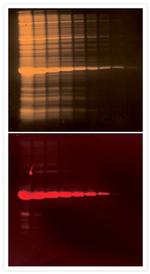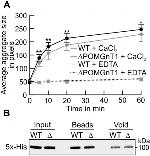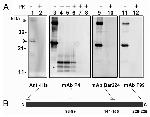Invitrogen
Penta-His Tag Monoclonal Antibody
This Antibody was verified by Cell treatment to ensure that the antibody binds to the antigen stated.
FIGURE: 1 / 7
Penta-His Tag Antibody (P-21315) in WB







Product Details
P-21315
Species Reactivity
Published species
Host/Isotype
Class
Type
Immunogen
Conjugate
Form
Purification
Storage buffer
Contains
Storage conditions
Shipping conditions
RRID
Product Specific Information
Sufficient material is supplied to stain 50-100 minigel blots (8 cm × 10 cm). For immunodetection of oligohistidine fusion proteins on blotting membranes, use the Penta-His antibody at a final concentration of between 0.1 µg/mL and 0.2 µg/mL (1:1,000 to 1:2,000 dilution of the stock solution). Standard buffers and blocking agents, such as 3% BSA (bovine serum albumin) may be used; however, milk powder should not be used, as it reduces sensitivity. Denaturation of the proteins is recommended to ensure exposure of the oligohistidine domain. Detect the Penta-His antibody with an antimouse IgG secondary antibody conjugated to either alkaline phosphatase or horseradish peroxidase. The enzyme activity can then be visualized using a chromogenic, fluorogenic or chemiluminescent substrate.
Upon receipt, the lyophilized antibody should be stored at 4°C. When properly stored, this product is stable for at least one year. To prepare a stock solution, reconstitute the antibody in 0.5 mL of deionized water (dH2O) to a final concentration of 0.2 mg/mL. Store the solution for up to 3 months at 4°C. For storage up to 6 months, divide the solution into single-use aliquots and freeze at -20°C. AVOID REPEATED FREEZING AND THAWING.
Immunohistochemical methods can be used to investigate the location of recombinant proteins expressed in particular cells within tissues or organs, as well as for determination of the subcellular localization of proteins after targeting to particular cell compartments. The Penta-His antibody has been used to detect a hexahistidine aggrecan fusion protein in the perinuclear Golgi and the endoplasmic reticulum of transiently transfected CHO cells. The technique can also be used to localize cellular proteins that interact with hexahistidine fusion proteins. Preparation of the cells or tissue: Fix the tissue with 2% paraformaldehyde and permeabilize with 0.25% Triton™ X-100. This relatively mild fixation protocol best preserves epitopes and best maintains the position of the protein within the cellular structure. Immunodetection for cells and tissues: Before applying the antibody to the tissue, block nonspecific binding sites using 5% bovine serum albumin (BSA). For immunodetection of the oligohistidine fusion protein, use the Penta-His antibody at a final concentration of 410 µg/mL (1:20 to 1:50 dilution of the stock solution). Detect the Penta-His antibody with an anti-mouse IgG secondary antibody conjugated to a fluorescent dye, alkaline phosphatase, or horseradish peroxidase. The fluorescent dye can be seen directly using a fluorescence-based microscope. The enzyme activity can be detected using a chromogenic or fluorogenic substrate.
Target Information
The oligohistidine domain is a Ni2+-binding peptide sequence comprising a string of four to six histidine residues. When the DNA sequence corresponding to the oligohistidine domain is fused in frame with a gene of interest, the resulting fusion protein can be easily purified using a nickel-chelating resin. The Penta-His monoclonal IgG1 antibody provides a sensitive method for specific detection of fusion proteins that have an oligohistidine domain comprising five or six consecutive histidine residues. The antibody does not recognize tetrahistidine domains or domains in which the histidine string is interrupted by another amino acid. The antibody binds to the oligohistidine domain regardless of the surrounding amino acid context and even when the group is partially hidden, although subtle differences in the amino acid context may change the sensitivity limit for a particular fusion protein. This antibody can be used to detect oligohistidine fusion proteins on western blots, dot blots or colony blots, or in tissues.
For Research Use Only. Not for use in diagnostic procedures. Not for resale without express authorization.
Bioinformatics
Protein Aliases: 5Xhis; Histidine 5X; pentahistidine

Performance Guarantee
If an Invitrogen™ antibody doesn't perform as described on our website or datasheet,we'll replace the product at no cost to you, or provide you with a credit for a future purchase.*
Learn more
We're here to help
Get expert recommendations for common problems or connect directly with an on staff expert for technical assistance related to applications, equipment and general product use.
Contact tech support
